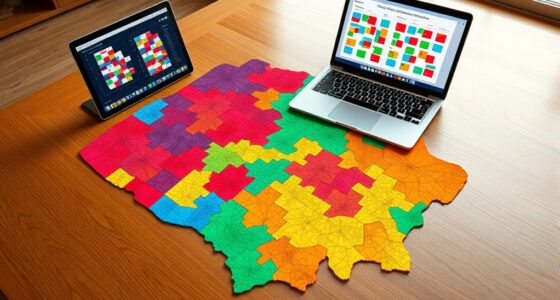Set theory helps you understand collections of objects called sets and how to compare their sizes. You use curly braces to define sets, and elements are the objects inside. For finite sets, you count elements to see which is larger. For infinite sets, you compare their sizes through special methods like bijections. Mastering these basics reveals a powerful way to analyze and compare different collections; exploring further uncovers even more fascinating concepts.
Key Takeaways
- Sets are collections of distinct objects, called elements, often denoted with curly braces, e.g., {1, 2, 3}.
- Finite sets are compared by counting elements; equal counts mean equal size, larger counts mean larger sets.
- Infinite sets require establishing a bijection (one-to-one correspondence) to compare their sizes.
- The notation |A| represents the size or cardinality of set A, used for both finite and infinite sets.
- Set theory uses precise language and notation to describe collections and compare their sizes systematically.

Have you ever wondered how mathematicians organize and categorize objects? They do this through the concept of sets—collections of distinct objects, called elements, that share a common property. Understanding how to compare these collections is fundamental in set theory, especially when it comes to determining their sizes. This is where the ideas of cardinality comparison and set notation come into play. By examining these tools, you can grasp how mathematicians analyze the size of different sets and establish relationships between them.
Cardinality comparison allows you to determine whether two sets are of the same size, or if one set is larger than the other. When sets are finite, comparison is straightforward: count the number of elements in each set and compare those counts. If both counts are equal, the sets have the same cardinality. If one count exceeds the other, that set is larger. For example, if set A has three elements and set B has five, then set A has a smaller cardinality than set B. This simple comparison becomes more complex when dealing with infinite sets, but the principle remains: mathematicians use special methods to compare their sizes, often relying on the concept of a one-to-one correspondence.
Set notation is a powerful language that makes these comparisons precise and clear. It allows you to define sets explicitly, such as using curly braces: {1, 2, 3} for a finite set of numbers. When comparing sizes, you might use notation like “|A|” to denote the cardinality of set A. For example, if |A| = 3 and |B| = 5, you instantly understand that set A has fewer elements than set B. For infinite sets, notation becomes even more important because counting elements directly isn’t feasible. Instead, mathematicians explore whether there exists a bijection—a one-to-one and onto mapping—between sets, to determine if they have the same cardinality.
Frequently Asked Questions
How Does Set Theory Apply to Real-World Data Analysis?
Set theory helps you analyze real-world data by organizing set data into collections, making it easier to identify overlaps, differences, and relationships. You can perform collection analysis to find commonalities or unique elements among groups, which is useful in areas like market segmentation or social network analysis. By applying set operations like union, intersection, and difference, you gain clearer insights and make informed decisions based on your data.
What Are the Differences Between Finite and Infinite Sets?
Ever wondered how sets can be so different? Finite sets have a limited number of elements, making set enumeration straightforward, while infinite sets go on endlessly, making cardinality comparison more complex. You can count the elements in a finite set, but with infinite sets, you compare their sizes through concepts like countability. So, the key difference lies in whether their size can be fully enumerated or not.
Can Sets Contain Other Sets as Elements?
Yes, sets can contain other sets as elements, creating nested sets. When a set includes another set as a member, it’s called set membership. For example, if you have a set A that contains another set B, then B is a nested set within A. This allows for complex structures and hierarchies in set theory, enabling you to organize and analyze collections of sets with varying levels of containment.
How Do Set Sizes Relate to Probability Theory?
You see, set sizes, or set cardinalities, directly impact probability theory because they determine how probability measures assign likelihoods. When working with finite sets, you divide the number of favorable outcomes by the total set size. For infinite sets, you use concepts like cardinality to understand their size, influencing how probabilities are assigned in more complex spaces. This connection helps you quantify uncertainty effectively.
What Are Common Methods to Compare the Sizes of Infinite Sets?
To compare the sizes of infinite sets, you use cardinality comparison. You look for a bijective function, which pairs each element of one set with exactly one element of the other, showing they have the same cardinality. If such a function exists, the sets are equally large. If not, you determine which set is larger by checking for injections or surjections, helping you understand their relative sizes even when infinite.
Conclusion
By exploring collections and their sizes, you’ve uncovered the fundamentals of set theory. As you investigate the properties and relationships between sets, you’ll notice patterns and truths emerging. This journey reveals how sets behave and interact, shaping your understanding of the mathematical universe. Keep questioning and exploring—each discovery builds your confidence. Ultimately, the more you investigate, the clearer the underlying principles become, solidifying your grasp of this fascinating branch of mathematics.









